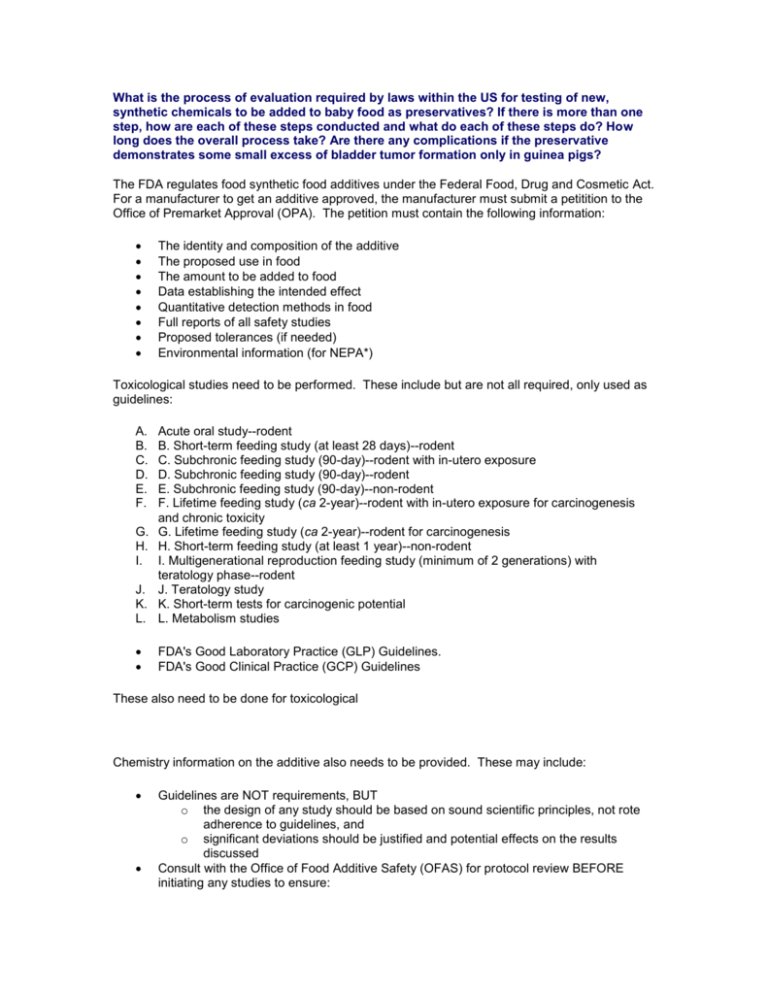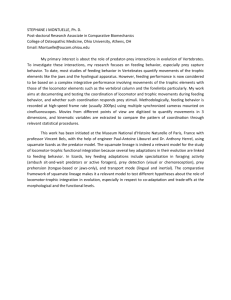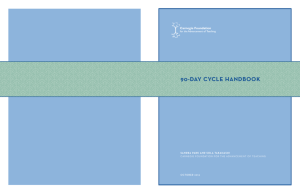MikeGeorge4
advertisement

What is the process of evaluation required by laws within the US for testing of new, synthetic chemicals to be added to baby food as preservatives? If there is more than one step, how are each of these steps conducted and what do each of these steps do? How long does the overall process take? Are there any complications if the preservative demonstrates some small excess of bladder tumor formation only in guinea pigs? The FDA regulates food synthetic food additives under the Federal Food, Drug and Cosmetic Act. For a manufacturer to get an additive approved, the manufacturer must submit a petitition to the Office of Premarket Approval (OPA). The petition must contain the following information: The identity and composition of the additive The proposed use in food The amount to be added to food Data establishing the intended effect Quantitative detection methods in food Full reports of all safety studies Proposed tolerances (if needed) Environmental information (for NEPA*) Toxicological studies need to be performed. These include but are not all required, only used as guidelines: A. B. C. D. E. F. J. K. L. Acute oral study--rodent B. Short-term feeding study (at least 28 days)--rodent C. Subchronic feeding study (90-day)--rodent with in-utero exposure D. Subchronic feeding study (90-day)--rodent E. Subchronic feeding study (90-day)--non-rodent F. Lifetime feeding study (ca 2-year)--rodent with in-utero exposure for carcinogenesis and chronic toxicity G. Lifetime feeding study (ca 2-year)--rodent for carcinogenesis H. Short-term feeding study (at least 1 year)--non-rodent I. Multigenerational reproduction feeding study (minimum of 2 generations) with teratology phase--rodent J. Teratology study K. Short-term tests for carcinogenic potential L. Metabolism studies FDA's Good Laboratory Practice (GLP) Guidelines. FDA's Good Clinical Practice (GCP) Guidelines G. H. I. These also need to be done for toxicological Chemistry information on the additive also needs to be provided. These may include: Guidelines are NOT requirements, BUT o the design of any study should be based on sound scientific principles, not rote adherence to guidelines, and o significant deviations should be justified and potential effects on the results discussed Consult with the Office of Food Additive Safety (OFAS) for protocol review BEFORE initiating any studies to ensure: o that the proper test data will be submitted, o that the analytical methodology will be adequate, and o that the validation methodology will be adequate. Submit all supporting raw data, including that for: o test materials, o standard preparation, o calibration curves, o standard and sample spectra, o limits of detection (LOD) and limits of quantitation (LOQ), o sample workup, and o sample calculations. Submit all other relevent information, for example: o technical brochures, and o material safety data sheets (MSDS). Discuss the results: o interpretations/conclusions should be scientifically sound and supported by the data. o DO NOT make any unsupported statments! Ensure that consistent information is presented throughout all sections of the petition, including those pertaining to: o chemistry, o toxicology, o environmental science, and o any other pertinent studies. The overall process can take anywhere from 6-72 months depending on the type of additive. If the preservative shows some excess bladder tumor formations in guinea pigs it would require further testing to determine whether or not it would be safe for humans. It would delay the preservative from being approved, perhaps leading to it being rejected. The FDA might approve it and require it to have a label stating it has been know to cause cancer in rodents such as nutrasweet has that label. Sources: http://vm.cfsan.fda.gov/~lrd/foodadd.html http://www.cfsan.fda.gov/~dms/opa2pmnt.html





